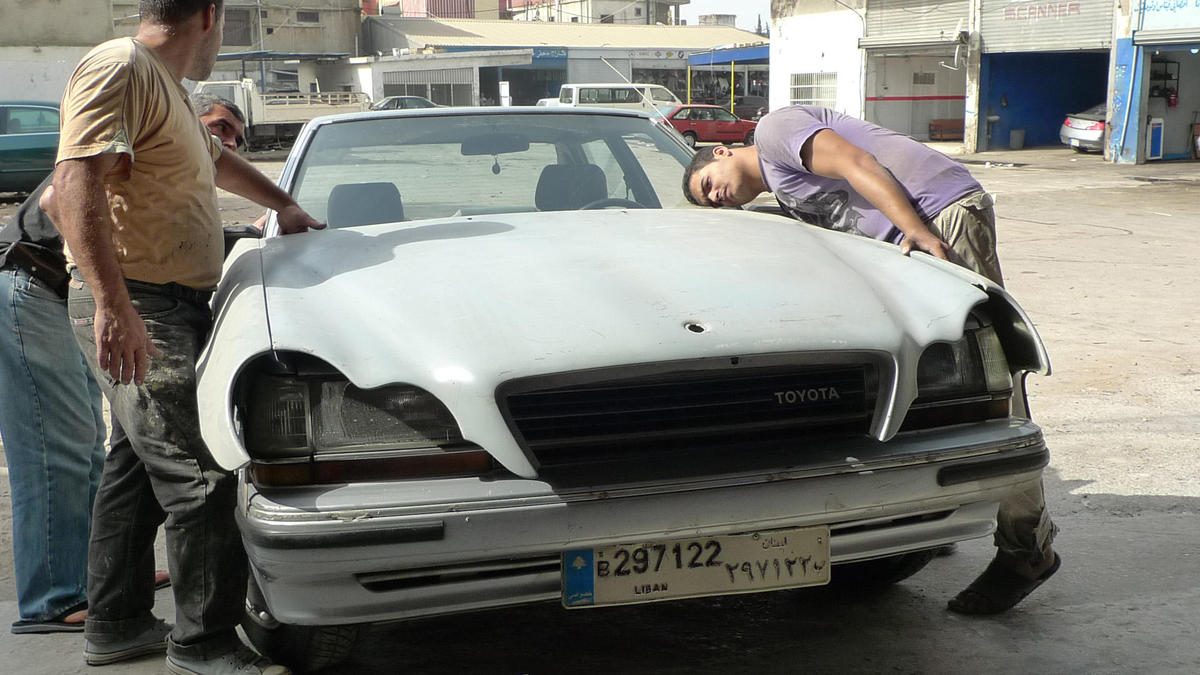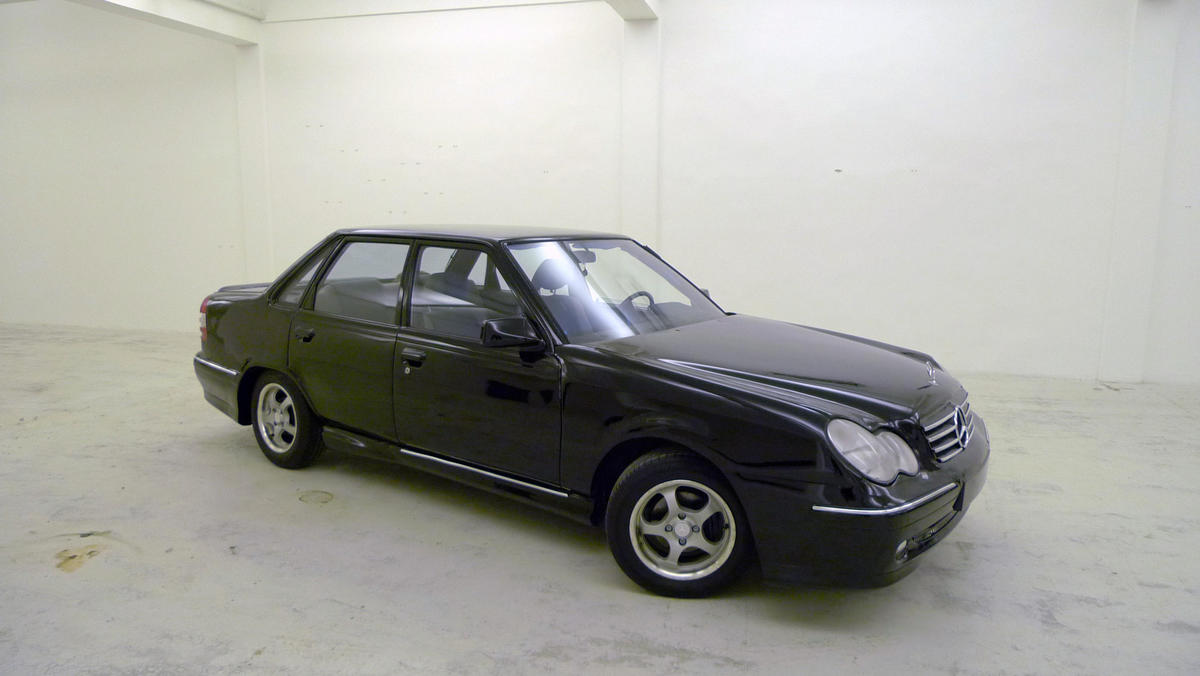
The funny thing about Franziska Pierwoss is that despite spending much of the past six months immersed in the intricacies of Beiruti car culture — from body kits and butterfly doors to the ups and downs of drifting — she doesn’t actually know how to drive.
This inconvenient fact did not endear her to the elaborate cast of characters at the garages who helped her transform a beat-up silver 1981 Toyota Corona into a slick black 2006 Mercedes-Benz C240 sedan. Pierwoss’s Toyota to Benz was the centerpiece of the Beirut Art Center’s Exposure 2011. For two months, it was parked at a jaunty angle in the middle of the ground-floor exhibition space — its curves a bit rough, its back end oddly square, its front grill clearly improvised, and its brand identity utterly questionable.
In the same way Lebanon’s countless plastic surgeons can rearrange a woman’s face around a Swiss ski-slope nose, or make her look as overtly alien as the pop star Nancy Ajram, the country boasts an elaborate gray economy for embellishing, revamping, and overhauling cars. With unemployment hovering (unofficially) around twenty-five percent and salaries stagnant against staggering cost-of-living increases, luxury vehicles are out of reach for all but a shrinking elite. But while a young man may not be able to afford a Mercedes or a BMW or an Escalade, for a mere fifty bucks he can make the doors of a humble Kia open upward like the wings of a DeLorean. And so it goes, modest cars customized with ostentatious tails, spoilers, rims, neon lights, police sirens, and alarm systems that shriek in riddles, jokes, and pop songs. Pierwoss ended up grafting a custom-made, absurdly flammable fiberglass body onto the hood of the old Toyota, cutting out chunks of the trunk to insert Mercedes-style taillights at the back. The rest of the work involved smoothing and molding and a paint job that took seven days.
Toyota to Benz isn’t really a work in progress so much as a project at a pivot. In the past, Pierwoss has created atmospheric performances that left piles of remains behind, whether bridal linens or a roomful of fried onions. With Toyota to Benz, she has a less redolent but more cumbersome remnant to contend with. Either she keeps the project going, which will entail sorting through all of the stories, photographs, films, receipts, documentation, and drama that she’s gathered so far to produce a book, a more elaborate installation, or a series of YouTube-style videos. Or she sells the car, destroys it, or simply learns how to drive it — at which point it will stop being an artwork at all, just a freakish family car.
In fact, the Toyota is exactly as old as Pierwoss, who was born in Tübingen, a university town south of Stuttgart. Her parents are originally from Poland, and moved around Germany every few years because her father was heavily involved in theater. Pierwoss went to high school in Swaziland, university in Leipzig, and in 2007, ended up in Lebanon as an exchange student on a DAAD scholarship. Her first love was not Beirut but the northern Lebanese city of Tripoli, where in 2008, she created an incredibly sly and delicate installation on the Rachid Karami International Fairground, threading Chinese ribbons around and between the Oscar Niemeyer–designed structures. The work embodied the fragility of a failed modernism — the place is a wreck— while evoking Lebanon’s lamentable surfeit of red tape. Because the fairground is managed by a government ministry, even turning the electricity on required approval from Beirut.
For several years, Pierwoss was back and forth between Beirut and Berlin, though of late she has been spending more time in Lebanon; the fact that she recently married and gave birth to a child no doubt contributed. The car itself originally belonged to the father of Pierwoss’s husband, Alexandre Habib, also known as the video artist and filmmaker Siska (who runs LABeirut, a collective devoted to Super 8 and 16mm film stock) and before that as the graffiti artist and rapper 6K, part of the brilliant but short-lived hip-hop outfits Kita Beirut and Kita’youn. Siska learned how to drive on that car, as did his older brother and two older sisters.
By her own admission, Pierwoss isn’t a video artist and doesn’t particularly care about process, but she filmed and took photographs at every stage of the production of Toyota to Benz, not least because it opened up so many subcultures she never would have known otherwise — illegal drifting competitions in Bourj Hammoud, legal drifting exhibitions supported by Lebanon’s Ministry of Youth and Sports, rows upon rows of body shops with crazy names and car parts strung from palm trees in Ouzai, the mechanics and paint specialists in the depths of Mar Mikhael (one of whom is referred to by all in the Armenian quarter as “The Muslim”), the guy who fixes up Alfa Romeos in a garage below her building, and the Spoiler Center, that vast, landmark-status emporium of classy-to-bling car accessories, which also happens to be owned by her landlord. The question now is what to do with all of that material, which tells at least three very different stories — about image, class, and capitalism — that have yet to be fully fleshed out. In both current and potentially future incarnations, Toyota to Benz is most obviously a critique of an image-conscious, surface-loving, status-obsessed society, and even in that not-seemingly-unique sense, intensely local.
“I don’t think the rest of the world is aware how insane the car thing is here,” says Pierwoss. On one hand, the valet parking for clubs is routinely designed to show off expensive cars while relegating the lesser makes to back lots, out of sight. On the other, “people are faced with so much crap here — on all levels of society — that car culture becomes a kind of dream, the big beauty of capitalism. If you want it and can’t get it, we’ll copy it, we’ll improvise.”
In some ways, Lebanon’s car culture is open. Pierwoss met a mechanic who fixes cars for drifting and offered to teach her how to drive and drift and compete. The sport, which involves intentionally oversteering so the back wheels lose their traction, the vehicle slides sideways, and the driver maintains control at high speed, is at once incredibly popular and virtually unknown to mainstream society. (Drifting has a much more public profile in the Gulf, where it makes for mass entertainment.) Among the auto shops in Ouzai, however, the world of car-work is conservative and closed. None of the mechanics there would speak to Pierwoss directly (her husband had to serve as interlocutor), and even after the work was complete, not one of them attended the opening, though they were invited. It was a relief, in a way. “How do I explain to a guy in Ouzai that I can’t pay him another $500, and then invite him to join a roomful of people in their finery, many of whom actually drive the same car? The white cube here is a much bigger clash than in other places, where you can pretend these hierarchies don’t exist.”
Maybe the most fascinating and complicated subtext, though, is Lebanon’s place in the global auto parts trade. “If you want to get rid of your car in Germany,” Pierwoss says, “you have to pay 100 or 200 euros to dispose of it. But there’s an entire industry of people who will pay you 100 or 200 euros, strip the car, sell the spare parts in Africa, and then somehow it ends up whole in Ouzai.” Lebanese in Germany have a monopoly on the secondhand car-part market; they are the guys who cut cars in half, ship them abroad, and weld them back together again. Dismembering cars is a common strategy for evading taxes and customs duties. (It was also part of an alleged Hizbullah money-laundering scheme exposed last year when the US Treasury Department closed down a local bank.) Unfortunately, cars that have been broken down and reassembled have a propensity to split in half again at high speeds. Usually, this just adds to the high number of car accidents that happen all the time in Lebanon (where road rules are optional and speeding against traffic on a hairpin mountain highway is fine), but it made the news briefly, in 2005, when a Mercedes re-dismembered itself, killing a member of parliament and his wife.
For now, Toyota to Benz is something of an albatross. Or a beached whale, perhaps, occupying precious real estate in the parking garage below the building where Pierwoss lives. Whatever she does now with the work, the car itself is a sight, riddled with bumps and flaws. She calls it “a monster, a complete Frankenstein.” But not just that. “It’s not only a portrait. It’s also a sculpture. It transports a lot,” she says. “My audience is not stupid. I don’t need to underestimate them, neither at the Beirut Art Center nor on the street. They know something strange happened here.”
